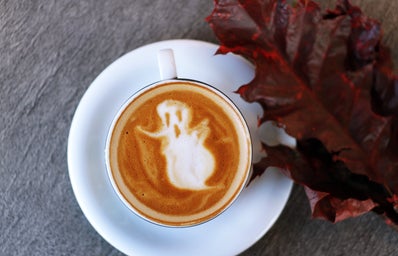Halloween, All Hallows Eve, Devil’s Night, whatever you may call it, it’s on October 31st and includes all things spooky. Where did this tradition of collecting candy, carving jack-o-lanterns, and dressing up some from?
Halloween comes from the Celtic festival Samhain. Samhain is one of the four main religious Pagan festivals. Samhain was celebrated during the midpoint of Fall Equinox and Winter Solstice to welcome in the harvest and usher in the “dark half of the year”. The Celtics believed that during Samhain, the barriers between the physical and spiritual world would thin and allow interactions between humans and people of the netherworld. In Ireland, the nights leading up to Samhain, people would put on costumes (a practice called mumming) and go door-to door singing songs to the dead. Cakes were given as payment. The celebration was conducted with Druid priests who would light a fire using a wheel (to represent the sun) and prayers would be said along with giving sacrifices (usually cattle). Families would let the fires in their hearth burn out and the flames from the wheel would be used to relight the hearth. These fires were lit near farms to protect all the families from fairies and witches. This ritual would last three days and nights where everyone in the community would be required to attend. If not, it was believed to result in punishment from the gods manifesting in death, illness, or spoiled harvests. Pranks were also a tradition during Samhain, but the tricks were typically blamed on the fairies.
In the middle ages carved turnips called jack-o-lanterns were created and attached to sticks embedded with coal. Later, the Irish changed turnips to pumpkins after immigrating to America. This tradition of carving vegetables came from the Irish folktale of a man named Stingy Jack. Stingy Jack invited the devil to have a drink with him but being stingy, he did not want to pay for his drink. He convinced the Devil to turn himself into a coin so Jack could buy their drinks. Once the Devil transformed, Jack kept the coin instead and put it into his pocket next to a silver cross that prevented the Devil from changing back into his original form. Jack eventually freed the devil with the condition that the Devil could not bother Jack for one year or claim his soul if he died. The following year Jack, again, tricked the devil into climbing up a tree to pick a piece of fruit and then carving a cross into the tree bark so the Devil could not come down. Eventually, Jack died and because he was an awful person, God would not let him into Heaven and the Devil kept his promise of not taking his soul to Hell. However, the Devil, upset with Jack’s tricks, sent him into the night with only a burning coal to light his path. Jack put that coal into a carved-out turnip and as the myth goes, has been roaming the Earth ever since. His ghostly figure was referred to Jack of the Lantern, eventually becoming jack-o-lantern. In Ireland and Scotland, people made their versions of Jack’s lanterns into scary faces and placing them near doors and windows to ward off Stingy Jack and other evil spirits.
As Christianity took over traditional Pagan communities, the church wanted to reform Samhain into a Christian celebration. Then when Celtic immigrants came to America in the 19th century, they mixed the traditional pagan practices with American culture to assimilate. In 1912 in Hiawatha, Kansas, a woman named Elizabeth Krebs helped to make the tradition of Halloween more child friendly. Every night on Halloween, kids in Hiawatha would go around town making an incredible amount of mischief. They would turn over outhouses, behead chickens, and destroy absolutely anything they could find. Elizabeth Krebs, founder of the Hiawatha Garden Club, woke up the day after Halloween to see her lush garden completely wrecked. She thought, “Why are all these children being so destructive?” and planned a party where the youth could burn off the excess, malevolent energy. November 1st, 1913, Elizabeth Krebs wakes up to again, find her garden torn to all hell. She spends the next year planning the biggest, most amazing Halloween party in all of Kansas with her own time and resources. Halloween night, October 31st, 1914, the costumed youth of Hiawatha, Kansas comes trickling into the town square. There was a band, apple bobbing, pumpkin decorating, and a whole bunch of other fun fueled activities. The kids marched with the band all the way to the Armstrong Opera House, dancing and enjoying themselves. The band keeps playing until the kids are exhausted. The next day, November 1st, 1914, Elizabeth Krebs wakes up and goes to look at her garden to find…nothing at all. Nothing at all happened to her garden. People of Hiawatha came up to her that day raving about how none of their possessions were destroyed and the rate of vandalism decreased precipitously. Why? All the hooligans that were once destroying the town, were at Elizabeth Krebs’s Halloween party. She helped to solidify how Americans and everyone around the world celebrated Halloween. That is how the idea of how we celebrate Halloween changed into what is currently is.
So to everyone, have a wonderful Halloween with great costumes, great candy, and great fun in the name of Samhain.


